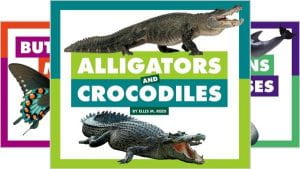 Cox, Lynne. Yoshi, Sea Turtle Genius: A True Story about an Amazing Swimmer. Illustrated by Richard Jones. Anne Schwartz Books, 2023. 978-0-593-42568-8. Unpaged. $18.99. Grades K-3.
Cox, Lynne. Yoshi, Sea Turtle Genius: A True Story about an Amazing Swimmer. Illustrated by Richard Jones. Anne Schwartz Books, 2023. 978-0-593-42568-8. Unpaged. $18.99. Grades K-3.
Written by a world famous swimmer, this engaging piece of creative nonfiction is the true tale of a loggerhead turtle’s oceanic journeys. The story begins as the baby turtle hatches from her egg on an Australian beach. After a few days of resting under the sand, the hatchling makes its way to the Indian Ocean with her brothers and sisters, while avoiding nearby predators. The tiny reptile swims all day and night to find a bed of brown algae, which she uses to protect herself and drift on for many months. After five years, the turtle, now the size of a house cat, finds that she has traveled across the Indian Ocean to the southern tip of Africa. One day while searching for food, the animal is caught up in a fishing net, which pulls her down despite her struggles. Fortunately, a fisherman on a boat saw the creature and rescued her from the net. He saw that she had a laceration in her shell and treated the wound. He gave her a name, Yoshi, and took care of her until the shell was healed. Once she was stronger, the fisherman took the loggerhead to an aquarium in Cape Town, where she lived for twenty years. Now that she was an adult, the aquarium staff felt that Yoshi could be returned to the ocean. First, they trained her to swim long distances in the tank alongside two divers, until she had the endurance to swim long distances. The turtle, now as big as a lion, was released with a tracking device. The scientists followed Yoshi’s travels along the west coast of Africa for food, but were surprised when she passed up a Cape Town nesting site and set out east toward Australia. After swimming nearly 23,000 miles over twenty-six months, Yoshi was back home where her life began. After mating with a male loggerhead, she laid her eggs on that very same beach. The text contains figurative language describing the animal’s size over time (“big as a smile,” the size of a house cat,”) and includes an author’s note with a photograph of the real Yoshi, who is still being tracked today. A site with teaching materials is listed. Jones uses paint for his beautiful illustrations, which are digitally edited. The images show seas that are full of life and include maps of the turtle’s journeys.
THOUGHTS: This is an amazing story depicting the tenacity of the loggerhead turtle as it faces predators, currents and other dangers while swimming extremely long distances. Readers will cheer on this remarkable animal as she fights the odds to complete her quest. Yoshi’s story is perfect to use in STEM units and works well as a read-aloud. This is a must-have for all elementary collections.
597.928 Sea Turtles
Picture Book


